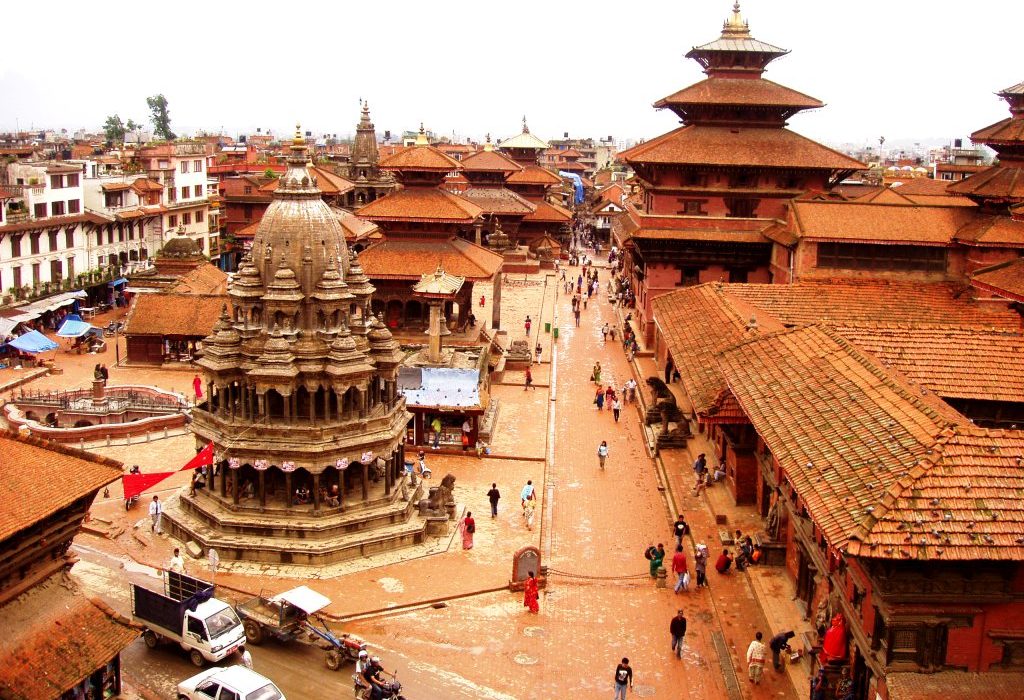
You might also like:
KATHMANDU has seven monuments that are listed as a UNESCO World Heritage.
Kathmandu Durbar Square
Pic: SuggestNepal
The palaces, temples and public spaces of this central part of Kathmandu are an incredible blend of living history. Dating back anywhere from the 15th to the 18th century, they are filled with incredible stone carvings, shrines, tourists and even souvenir sellers where you can haggle over Indian styled clothing or Tibetan jewelry. Find a spot to sit and watch locals visiting the temples, feeding the pigeons, filling their water pots or simply sitting around and chatting.
Patan Durbar Square

Pic: ourglobaltrek
The Patan Durbar Square is the beating heart of Patan City and dates to the 3rd century A.D. As in Kathmandu there is a mixture of courtyards, temples and palace buildings around the various squares. There is also a former royal palace complex housing statutes and religious objects. As in Kathmandu enjoy the sights but leave plenty of time for people watching as well. There are a number of Hindu festivals held throughout the year in the Durbar Squares – a particularly good time to visit.
Bhaktapur Durbar Square

Pic: Wikimedia Commons
The final of the three Durbar Squares is Bhaktapur, about 20 kilometres from Kathmandu. It is famed for its terracotta and carved wood columns, elaborate carvings, gilded roofs, magnificent courtyards and various temples. There is a far more spacious feeling to Bhaktapur than the other Durbar Squares in the Kathmandu Valley, largely because an earthquake knocked out some of the buildings back in 1934. However while many of the buildings, courtyards and temples have been lost, there’s more than enough to take in and plenty of room to move around in. This is often the favourite of the Durbar Squares for many tourists.
Swayambhu

Pic: Wikimedia Commons
The religious ensemble of Swayambhu includes a 2000 year old Buddhist stupa, located on a hillock above the Kathmandu Valley. It is made of brick and clay and the eyes of Lord Buddha are painted on the fours sides of the spire base. To get to the temple you climb up steep staircases past chanting monks and marauding monkeys to the top. The views from the top are worth the effort.
Bauddhanath

Pic: Gregory White Photography
While Swayambhu is the oldest, Bauddhanath is the largest stupa in Nepal. It is located on an ancient trade route from Tibet and Tibetans have always rested and prayed here. There is still a real sense of religious life here and pilgrims circumnavigate the stupa spinning prayer wheels – it is particularly busy early in the morning.
Pashupati

Pic: goasianjourney
This extensive Hindu temple precinct is also the world’s most sacred temple of Lord Shiva and dates back to 400 A.D. It was once forbidden for non Hindus to enter and while Hindu pilgrims continue to flock here all are now welcome. During Hindu festivals, of which there are many, the temple is particularly colourful with ghee lamps and incense sticks, and bathing pilgrims in the river.
Changu Narayan

Pic: Wikimedia Commons
Changu Narayan is a traditional Newari settlement, and a Hindu temple complex located just outside Kathmandu. The tiered temples are a spectacular combination of overlapping terracotta, decorative carvings and brass ornamentation. Architectural buffs will love it. It is considered Nepal’s oldest temple, dating from the fifth century A.D.
Source: travelwireasia.com
